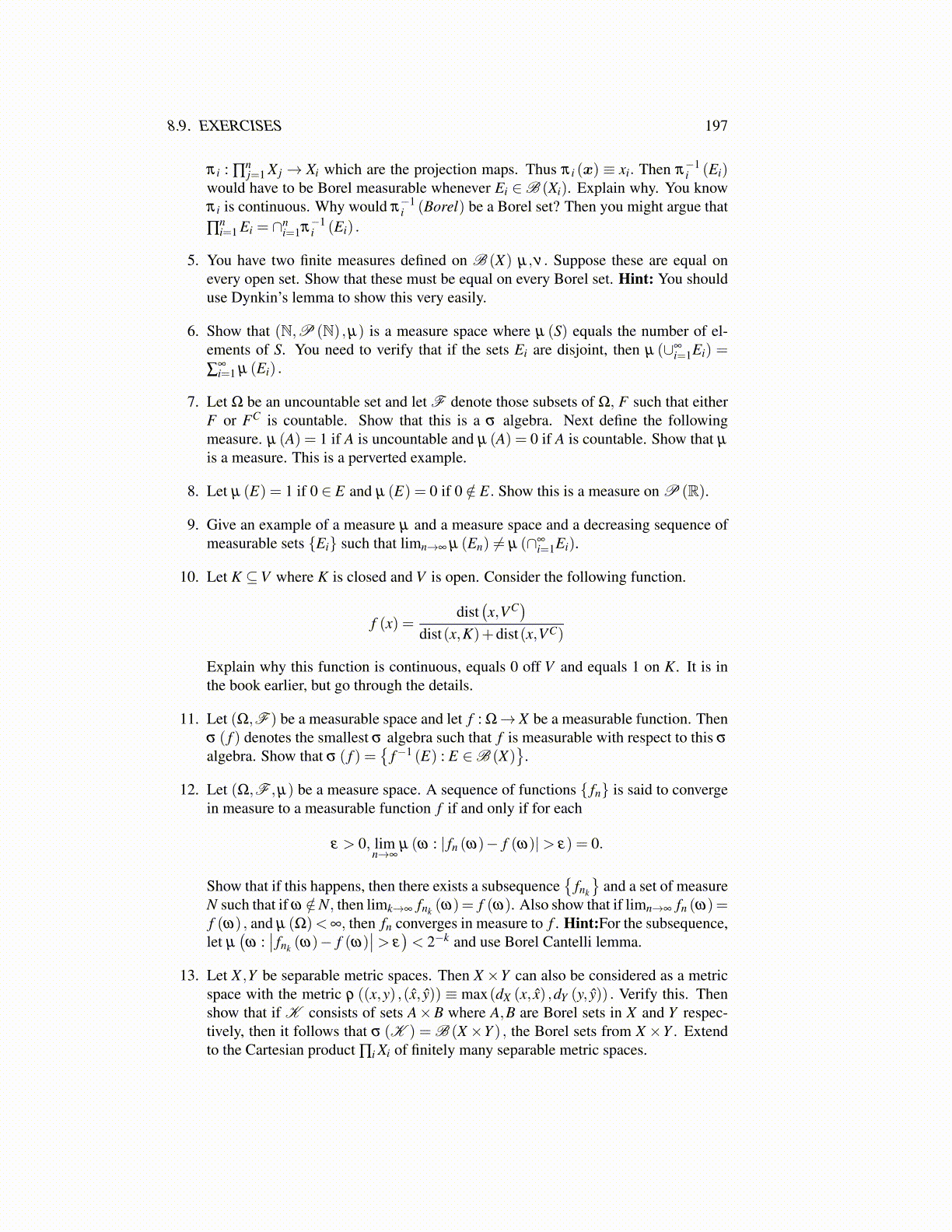
8.9. EXERCISES 197
π i : ∏nj=1 X j → Xi which are the projection maps. Thus π i (x) ≡ xi. Then π
−1i (Ei)
would have to be Borel measurable whenever Ei ∈B (Xi). Explain why. You knowπ i is continuous. Why would π
−1i (Borel) be a Borel set? Then you might argue that
∏ni=1 Ei = ∩n
i=1π−1i (Ei) .
5. You have two finite measures defined on B (X) µ,ν . Suppose these are equal onevery open set. Show that these must be equal on every Borel set. Hint: You shoulduse Dynkin’s lemma to show this very easily.
6. Show that (N,P (N) ,µ) is a measure space where µ (S) equals the number of el-ements of S. You need to verify that if the sets Ei are disjoint, then µ (∪∞
i=1Ei) =
∑∞i=1 µ (Ei) .
7. Let Ω be an uncountable set and let F denote those subsets of Ω, F such that eitherF or FC is countable. Show that this is a σ algebra. Next define the followingmeasure. µ (A) = 1 if A is uncountable and µ (A) = 0 if A is countable. Show that µ
is a measure. This is a perverted example.
8. Let µ (E) = 1 if 0 ∈ E and µ (E) = 0 if 0 /∈ E. Show this is a measure on P (R).
9. Give an example of a measure µ and a measure space and a decreasing sequence ofmeasurable sets {Ei} such that limn→∞ µ (En) ̸= µ (∩∞
i=1Ei).
10. Let K ⊆V where K is closed and V is open. Consider the following function.
f (x) =dist(x,VC
)dist(x,K)+dist(x,VC)
Explain why this function is continuous, equals 0 off V and equals 1 on K. It is inthe book earlier, but go through the details.
11. Let (Ω,F ) be a measurable space and let f : Ω→ X be a measurable function. Thenσ ( f ) denotes the smallest σ algebra such that f is measurable with respect to this σ
algebra. Show that σ ( f ) ={
f−1 (E) : E ∈B (X)}
.
12. Let (Ω,F ,µ) be a measure space. A sequence of functions { fn} is said to convergein measure to a measurable function f if and only if for each
ε > 0, limn→∞
µ (ω : | fn (ω)− f (ω)|> ε) = 0.
Show that if this happens, then there exists a subsequence{
fnk
}and a set of measure
N such that if ω /∈N, then limk→∞ fnk (ω)= f (ω). Also show that if limn→∞ fn (ω)=f (ω) , and µ (Ω)<∞, then fn converges in measure to f . Hint:For the subsequence,let µ
(ω :∣∣ fnk (ω)− f (ω)
∣∣> ε)< 2−k and use Borel Cantelli lemma.
13. Let X ,Y be separable metric spaces. Then X ×Y can also be considered as a metricspace with the metric ρ ((x,y) ,(x̂, ŷ)) ≡ max(dX (x, x̂) ,dY (y, ŷ)) . Verify this. Thenshow that if K consists of sets A×B where A,B are Borel sets in X and Y respec-tively, then it follows that σ (K ) = B (X×Y ) , the Borel sets from X ×Y . Extendto the Cartesian product ∏i Xi of finitely many separable metric spaces.